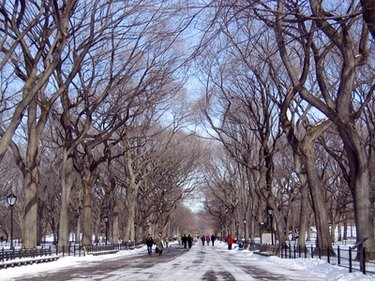
Pruning, or removing dead and undesirable growth, can help ensure that an elm tree enjoys a long, healthy life, while also providing optimal aesthetic value. However, before you take out the pruning shears and begin cutting and snipping away at the elm in your yard, make sure that the time is right for pruning. Pruning at the incorrect times can cause injury to an elm tree and can even make the tree more susceptible to Dutch elm disease, which is a devastating fungal disease that elm bark beetles spread.
By Season
Video of the Day
As with many types of deciduous tree, the ideal pruning time for an elm tree is early spring, as TreeHelp.com notes. During the early spring, hard, thick tissue, known as callus tissue, develops rapidly over the areas you prune. The callus tissue protects elm trees from invading pests, which in turn helps prevent the spread of Dutch elm disease. In comparison, waiting until summer to prune an elm can deter new growth and disrupt foliage production. Waiting even longer to prune, such as until late summer or early fall, can cause rapid regrowth of the shoots and branches you cut back. As a result, the elm tree can suffer from cold damage over the winter, as the new growth may not have ample time to harden.
Video of the Day
By Year
According to TreeHelp.com, you should thoroughly prune an elm tree once every three years. Pruning an elm more frequently than this can interfere with the tree's development, potentially stunting its growth. However, if you have a young elm tree that you have just planted in the yard, a different pruning schedule may be necessary. As the Virginia Cooperative Extension notes, with a young tree, leaving on temporary branches for three or four years following planting can help protect the tree's bark from sun scald and can also help increase trunk strength and food production. Temporary branches are branches that grow below scaffolding branches, which are the branches that form the framework of a tree's canopy. According to Virginia Cooperative Extension, after the three or four years is up, you can gradually remove temporary branches over the following two or three years.
Exceptions
If you notice that your elm tree is slow to rejuvenate following a thorough pruning session, you may want to consider even less frequent pruning, such as once every four or five years. However, apart from these thorough pruning sessions, which involve trimming primary branches, you can perform some minor pruning on an annual basis. This minor pruning involves removing water sprouts, which are vigorous, undesirable shoots that grow off of elm branches and removing suckers, which are vigorous, undesirable shoots that grow off of elm roots and trunks.
Following Leader Damage
If the leader of your elm tree snaps off or becomes irrevocably damaged due to disease or weather, immediate pruning is required. The leader of a tree is its vertical, centralized branch that grows up from the trunk. To repair a lost leader, you must train a new branch to grow in its place, a process that involves pruning competing branches.